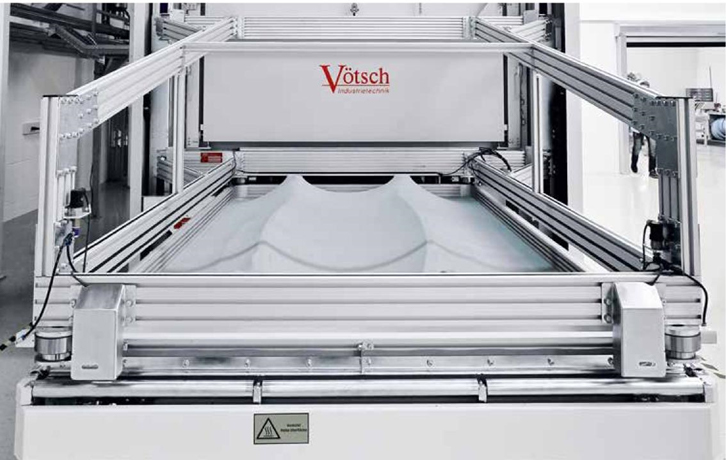CFRP composite components from Vötschtechnik tempering ovens
Safe, stable, light, and robust – materials used in the aerospace industry are subject to extremely stringent requirements. Rightly so, as this is done to ensure the safety of people. Tempering ovens by vötschtechnik help to make components from composite materials more reliable and safer – as for the Airbus A350 XWB.

Due to their positive characteristics, carbon fibre reinforced plastics (CFRP) are among the most important materials in aerospace engineering. Composites, i.e. composite materials are produced with the help of special tempering ovens in which carbon fibres are melted together with a matrix and cured. “The plastic is more or less the filler and the fibres form the matrix. Without this bond with the plastic resin, the carbon fibres would not retain any particular shape,” explains Reiner Wiesehöfer, Director of the Heating Technology division at Vötsch. Due to the very low density and high stiffness, the material is ideal for the constructionof many aircraft components. Compared to other materials such as steel, CFRP is extremely light and significantly stronger. The composite material is used on components such as wing shells, fuselage segments, vertical stabilisers and landing flaps.
Airbus places its trust in the know-how of Weiss Technik
Vötsch engineers are building an innovative, specialised oven for Airbus Helicopters, which is used for the construction of the aircraft doors of the wide-body aircraft A350 XWB. CFRP constitutes more than 50 % of the material of this machine. In this manner, the airlines set to use the wide-body aircraft in the future will save fuel and help preserve the environment. This also makes it possible to transport more people and heavier loads.
Manufacturing process in three phases
The three phases of the production process for the vötschtechnik continuous oven are evenly spaced. An airplane door consists of about 80 to 100 components. The first phase begins when Airbus Helicopters‘ production employees drape the components as a dry base layer on a table with a system slab.
Phase 1: The components are first covered with a special rubber membrane, placed in a vacuum and compacted with the binding material at an exactly prescribed temperature. This creates the blank moulds of the component. Then the plastic resin is filled, without creating air bubbles, which would make the resulting product unusable.
Phase 2: After loading the right programme for the control of vacuum and temperature, the lifting gate of the continuous oven opens and the batch moves inside. In the oven, the batch is exposed to temperatures between 140 to 180 degrees Celsius for a period of about 30 minutes. The homogeneity of the oven temperature is especially important for the later product quality. “This makes the construction of ovens of this size especially challenging” according to Reiner Wiesehöfer. “Despite the large dimensions of the systems it is important to achieve as exact of a temperature distribution as possible so that the parts cure evenly. Only this way can you produce components of a usable quality with the desired characteristics.” The vacuum further ensures that the shape continues to be stable even at high temperatures. The oven heats both with air recirculation and the help of infra-red lamps.
Phase 3: After this, the lifting gate opens at the exit and the palettes are transported to the cooling area. Depending on the batch, the cooling takes place with air of 4 to 8 degrees Celsius. In order to ensure an even step frequency in the circulation of the system, the cooling time always remains the same. The composite material must be cooled specifically in a way that prevents damaging internal stress. “For large components, we achieve equal cooling times by means of correspondingly low temperatures,” explains Erwin Ninic, Project Manager for Airbus Helicopters. “For smaller components, the temperature is correspondingly higher.“ After the cooling, the lifting slab lowers again and the system slab is moved back under the system. The cycle in the loading station begins again.
Professional and cost-effective
Other important factors in the construction of the special ovens are user-friendliness and safe operation. For instance, the redesigned photoelectric gate turns on and off automatically, so that production can proceed without confirmation and thus without interruptions. Vötsch engineers have also optimised the accessibility of the machine parts. This significantly facilitates regular maintenance and reduces the required downtime to a minimum. In this manner, the vötschtechnik system makes it possible to optimise/accelerate production and at the same time allows for economic and cost-effective operation.